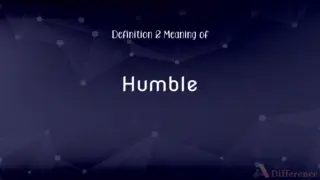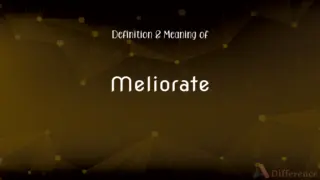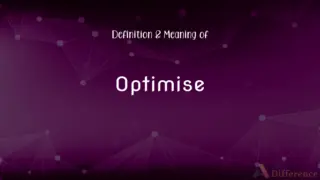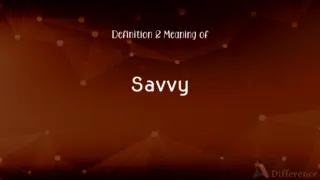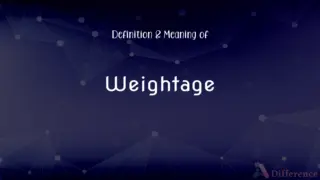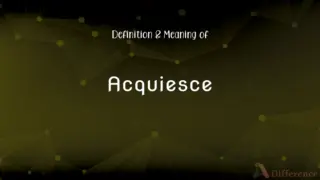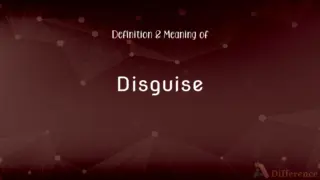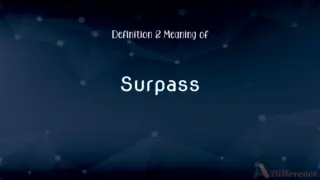Seesaw vs. Sway — What's the Difference?
Edited by Tayyaba Rehman — By Maham Liaqat — Updated on March 28, 2024
A seesaw is a back-and-forth motion on a pivot point, while sway involves a gentle, rhythmic side-to-side movement.

Difference Between Seesaw and Sway
Table of Contents
ADVERTISEMENT
Key Differences
A seesaw, often found in playgrounds, involves a board balanced on a central fulcrum, allowing two people to ride on either end, moving up and down alternately. Whereas sway refers to a movement that is more fluid and can describe the motion of trees in the wind, a person's gait, or the oscillation of a building.
The movement of a seesaw is controlled and predictable, with each side moving in direct response to the other. On the other hand, sway is often influenced by external forces like wind or balance, and its rhythm can vary in speed and intensity.
Seesaws require a physical structure and are specifically designed for reciprocal motion. Sway, however, can occur in various contexts and doesn’t require a specific apparatus. It can describe both physical objects and abstract concepts, like the sway of public opinion.
The term "seesaw" is also used metaphorically to describe situations where there is a rapid shift back and forth between two states or opinions. In contrast, "sway" can denote influence or control, as in swaying someone’s opinion, in addition to its physical movement meaning.
While both seesaw and sway involve motion, the former is mechanical and linear, focusing on the vertical plane. Sway is more organic and can encompass movements in multiple planes, often horizontal.
ADVERTISEMENT
Comparison Chart
Motion
Back-and-forth on a pivot point
Gentle, rhythmic side-to-side
Control
Controlled by riders’ actions
Influenced by external forces
Structure
Requires a seesaw board
No specific structure needed
Application
Mostly recreational
Varied, including physical and metaphorical
Direction
Vertical
Can be horizontal or multidirectional
Metaphorical Use
Describes shifts in situations
Often refers to influence or persuasion
Compare with Definitions
Seesaw
A long plank balanced in the middle so that, as one end goes up, the other goes down.
The children played on the seesaw, taking turns pushing off the ground.
Sway
To move or swing slowly from side to side.
The trees swayed gently in the breeze.
Seesaw
A play equipment on playgrounds.
They installed a new seesaw at the park, much to the delight of the kids.
Sway
A measure of control or influence.
The veteran politician held significant sway over the party's policies.
Seesaw
Symbolic of fluctuating situations.
The stock market seesawed throughout the day, ending where it started.
Sway
To influence or affect.
He has the ability to sway the crowd with his speeches.
Seesaw
Describes reciprocal motion.
The discussion seesawed between optimistic and pessimistic forecasts.
Sway
Motion without a fixed pattern.
The ship swayed on the high seas, unsettling the passengers.
Seesaw
To move up and down or back and forth.
The debate seesawed between the two viewpoints without reaching a conclusion.
Sway
Describes a gentle, rhythmic motion.
The rhythm of the music made the dancers sway.
Seesaw
A seesaw (also known as a teeter-totter or teeterboard) is a long, narrow board supported by a single pivot point, most commonly located at the midpoint between both ends; as one end goes up, the other goes down. These are most commonly found at parks and school playgrounds.
Sway
To swing back and forth or to and fro.
Seesaw
A long plank balanced on a central fulcrum so that with a person riding on each end, one end goes up as the other goes down. Also called regionally dandle, dandle board, teedle board, teeter, teeterboard, teeter-totter, tilt1, tilting board.
Sway
To incline or bend to one side; veer
She swayed and put out a hand to steady herself.
Seesaw
The act or game of riding a seesaw.
Sway
To incline toward change, as in opinion or feeling
He swayed toward trying out for the chorus.
Seesaw
A back-and-forth or up-and-down movement.
Sway
To fluctuate, as in outlook.
Seesaw
An action or process in which something repeatedly changes from one condition or situation to another
The seesaw in temperatures.
Sway
To cause to swing back and forth or to and fro
The breeze swayed the wheat.
Seesaw
To play on a seesaw.
Sway
To cause to incline or bend
The wind swayed the trees toward the house.
Seesaw
To move back and forth or up and down.
Sway
To exert influence or control over
His speech swayed the voters.
Seesaw
To change back and forth from one condition or situation to another
The lead seesawed for much of the tennis match.
Sway
(Nautical) To hoist (a mast or yard) into position.
Seesaw
A structure composed of a plank, balanced in the middle, used as a game in which one person goes up as the other goes down.
Sway
To rule or govern.
Seesaw
A series of up-and-down movements.
Sway
To wield, as a weapon or scepter.
Seesaw
A series of alternating movements or feelings.
Sway
The act of moving from side to side with a swinging motion.
Seesaw
An abnormal breathing pattern caused by airway obstruction, characterized by paradoxical chest and abdominal movement.
Sway
Influence or control
The mayor has a lot of sway in our town.
Seesaw
(intransitive) To use a seesaw.
Sway
The act of swaying; a swaying motion; a swing or sweep of a weapon.
Seesaw
To fluctuate.
Sway
A rocking or swinging motion.
The old song caused a little sway in everyone in the room.
Seesaw
(transitive) To cause to move backward and forward in seesaw fashion.
Sway
Influence, weight, or authority that inclines to one side
I doubt I'll hold much sway with someone so powerful.
Seesaw
Fluctuating.
Sway
Preponderance; turn or cast of balance.
Seesaw
A play among children in which they are seated upon the opposite ends of a plank which is balanced in the middle, and move alternately up and down.
Sway
Rule; dominion; control; power.
Seesaw
A plank or board adjusted for this play.
Sway
A switch or rod used by thatchers to bind their work.
Seesaw
A vibratory or reciprocating motion.
He has been arguing in a circle; there is thus a seesaw between the hypothesis and fact.
Sway
The maximum amplitude of a vehicle's lateral motion.
Seesaw
Same as Crossruff.
Sway
To move or swing from side to side; or backward and forward; to rock.
Sway to the music
The trees swayed in the breeze.
Seesaw
To move with a reciprocating motion; to move backward and forward, or upward and downward.
Sway
To move or wield with the hand; to swing; to wield.
To sway the sceptre
Seesaw
To cause to move backward and forward in seesaw fashion.
He seesaws himself to and fro.
Sway
To influence or direct by power, authority, persuasion, or by moral force; to rule; to govern; to guide. Compare persuade.
Do you think you can sway their decision?
Seesaw
Moving up and down, or to and fro; having a reciprocating motion.
Sway
To cause to incline or swing to one side, or backward and forward; to bias; to turn; to bend; warp.
Reeds swayed by the wind
Judgment swayed by passion
Seesaw
A plaything consisting of a board balanced on a fulcrum; the board is ridden up and down by children at either end
Sway
(nautical) To hoist (a mast or yard) into position.
To sway up the yards
Seesaw
Ride on a plank
Sway
To be drawn to one side by weight or influence; to lean; to incline.
Seesaw
Move up and down as if on a seesaw
Sway
To have weight or influence.
Seesaw
Move unsteadily, with a rocking motion
Sway
To bear sway; to rule; to govern.
Sway
To move or wield with the hand; to swing; to wield; as, to sway the scepter.
As sparkles from the anvil rise,When heavy hammers on the wedge are swayed.
Sway
To influence or direct by power and authority; by persuasion, or by moral force; to rule; to govern; to guide.
The will of man is by his reason swayed.
She could not sway her house.
This was the raceTo sway the world, and land and sea subdue.
Sway
To cause to incline or swing to one side, or backward and forward; to bias; to turn; to bend; warp; as, reeds swayed by wind; judgment swayed by passion.
As bowls run true by being madeOn purpose false, and to be swayed.
Let not temporal and little advantages sway you against a more durable interest.
Sway
To hoist; as, to sway up the yards.
Sway
To be drawn to one side by weight or influence; to lean; to incline.
The balance sways on our part.
Sway
To move or swing from side to side; or backward and forward.
Sway
To have weight or influence.
The example of sundry churches . . . doth sway much.
Sway
To bear sway; to rule; to govern.
Hadst thou swayed as kings should do.
Sway
The act of swaying; a swaying motion; the swing or sweep of a weapon.
With huge two-handed sway brandished aloft.
Sway
Influence, weight, or authority that inclines to one side; as, the sway of desires.
Sway
Preponderance; turn or cast of balance.
ExpertWhen to advance, or stand, or turn the swayOf battle.
Sway
Rule; dominion; control.
When vice prevails, and impious men bear sway,The post of honor is a private station.
Sway
A switch or rod used by thatchers to bind their work.
Sway
Controlling influence
Sway
Pitching dangerously to one side
Sway
Move back and forth or sideways;
The ship was rocking
The tall building swayed
She rocked back and forth on her feet
Sway
Move or walk in a swinging or swaying manner;
He swung back
Sway
Win approval or support for;
Carry all before one
His speech did not sway the voters
Sway
Cause to move back and forth;
Rock the cradle
Rock the baby
The wind swayed the trees gently
Common Curiosities
What causes a seesaw to move?
A seesaw moves due to the alternating force applied by the riders on either end, pushing off the ground.
Is seesawing a physical activity?
Yes, seesawing is a physical activity that involves reciprocal movements on a seesaw apparatus.
What does it mean to sway someone?
To sway someone means to influence or persuade them to change their opinion or decision.
How does sway affect buildings?
Sway can affect tall buildings by causing them to move slightly in response to wind or seismic activity, which is considered in their design.
What might a gentle sway indicate?
A gentle sway often indicates a calm, rhythmic movement, such as trees moving in a light breeze.
Where can you find a seesaw?
Seesaws are commonly found in children's playgrounds.
How do engineers reduce sway in tall buildings?
Engineers use various techniques to reduce sway in tall buildings, including mass dampers and tuned spring systems.
Do all seesaws balance perfectly in the middle?
Most seesaws are designed to balance around a central fulcrum, but the balance can be adjusted for the riders' weights.
Is it possible for sway to be dangerous?
Yes, excessive sway, especially in structures like bridges or buildings, can be dangerous and is something engineers strive to minimize.
Can sway be controlled?
Sway can be both involuntary, as with a tree in the wind, or controlled, as in a dancer's movements.
Can the term "seesaw" be used metaphorically?
Yes, "seesaw" can be used metaphorically to describe situations where there is a rapid and repeated change between two conditions or states.
Why do children enjoy seesaws?
Children enjoy seesaws because of the unique sensation of flying and falling they provide, along with the cooperative play aspect.
Can sway be used in a positive context?
Yes, sway can have a positive connotation when referring to the ability to influence others positively or the soothing motion of swaying.
Can sway be a form of art?
Yes, sway in dance and movement can be considered a form of art, expressing emotion and beauty through motion.
How do people react to sway in high places?
Reactions to sway in high places, like skyscrapers or bridges, can range from exhilaration to discomfort, depending on the individual's sensitivity to motion.
Share Your Discovery

Previous Comparison
Neil vs. Neal
Next Comparison
Apartment vs. BuildingAuthor Spotlight
Written by
Maham LiaqatEdited by
Tayyaba RehmanTayyaba Rehman is a distinguished writer, currently serving as a primary contributor to askdifference.com. As a researcher in semantics and etymology, Tayyaba's passion for the complexity of languages and their distinctions has found a perfect home on the platform. Tayyaba delves into the intricacies of language, distinguishing between commonly confused words and phrases, thereby providing clarity for readers worldwide.


































